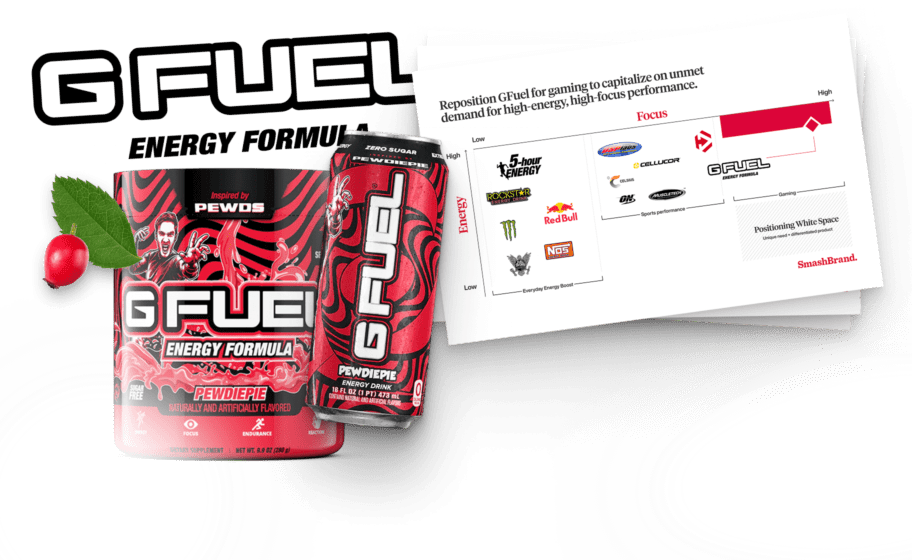Research indicates that 55% of initial brand impressions are visual which encompasses brand colors, fonts, typography, images, and logo design. What are your thoughts on your current branding? Is it putting your brand’s best foot forward? If not, a partial rebranding strategy could be the solution.
The consumer market is constantly changing. Looking back over the past decade, we can see how consumer preferences have evolved. Even well-established brands cannot thrive without adapting to these rapid changes. This is a key reason why companies often update their logo designs and sometimes even consider a partial rebranding.
There is concrete evidence demonstrating the impact of a well-executed partial rebrand. For instance, Aspire Energy experienced a 13-point lift in purchase intent after SmashBrand rebranded its package design. In this article, you will learn everything about building an effective partial rebranding campaign and executing it correctly.
When to Consider Partial Rebranding?
While companies may sometimes overlook its effectiveness, partial rebranding can be a powerful strategy to revitalize a brand. Unlike a total rebrand, partial rebranding allows businesses to update a specific aspect of the existing brand identity selectively. In several situations, a complete rebranding can be overkill, and companies must use a partial one instead.
Modernizing Visual Elements
Due to changing market trends, a brand’s visual identity can dilute over time. Under such conditions, it may fail to resonate with the current target audience. Therefore, a partial rebranding focused on refreshing these visual elements can breathe new life into the brand while preserving its core equity.
For instance, EarthBreeze underwent a packaging update to align with its sustainable ethos, while Aspire Energy drink revamped its packaging for a bolder look. Both companies experienced an uptrend in purchase intent by 13 points in major retail stores.
Reflecting Organizational Changes
A partial rebrand can be an effective strategy for companies undergoing significant organizational changes such as mergers and acquisitions. A systematically designed strategy can help seamlessly integrate newly acquired brands or reflect the consolidation of multiple entities under one umbrella brand.
Mergers and acquisitions often lead to scenarios where a more extensive, well-established brand acquires a smaller, niche brand with a strong following in a specific market. In such cases, a complete rebrand may alienate the brand’s loyal customer base and diminish its current brand equity.
Revitalizing Perceptions
When a current brand suffers from an outdated or negative perception despite having a solid core identity, consider partial rebranding to reposition it. Various rebranding examples indicate the success of this strategy. For instance, Kraft Heinz partially rebranded to revitalize their brand image. After updating its visual identity and brand messaging, the company successfully aligned its brand with modern consumer preferences while retaining brand recognition.
Another advantage of a partial rebrand strategy is its more focused and cost-effective approach to updating specific brand elements over a controlled rebranding timeline. It also minimizes disruptions to the existing brand equity.
Partial Rebranding vs Full Rebrand
| Aspect | Partial Rebrand | Full Rebrand |
| Scope | Refreshes specific elements. Often used to modernize or realign a brand with evolving market conditions or audience preferences. | Completely transforms the brand image to influence how the audience perceives the company. |
| Elements | Updates logo, color palette, design, and specific marketing materials while retaining original brand elements. | Overhauls everything from the company name to its purpose, market, and brand identity. |
| Purpose | Modernize the brand’s visual identity, adapt to market changes, and attract new audiences while maintaining brand recognition. | Significant company changes, such as mergers, repositioning, or foundational shifts, create a new brand image |
| Timeframe | Depending on the extent of changes, it can be completed in a shorter time frame, typically a few months. | It often requires a longer timeframe, ranging from several months to over a year. |
| Budget | Generally, it involves lower costs than a complete rebrand, focusing on updating specific elements rather than a complete overhaul. | Significant company changes, such as mergers, repositioning, or foundational shifts, create a new brand image. |
| Risk of Confusion | There is less risk of confusing existing customers as core brand elements remain intact, maintaining continuity and brand recognition. | Due to the extensive changes, there is a higher risk of confusing existing customers, impacting customer loyalty and recognition. |
| Market Impact | It helps the brand stay relevant and adapt to changing market trends without alienating existing customers. | Positions the brand for a significant shift in market perception, potentially attracting new audiences. |
Executing a Partial Rebrand
Executing a successful partial rebrand requires a well-defined rebranding strategy that aligns with your brand development goals. The key steps involve assessing rebranding reasons and costs, conducting market research to inform brand strategy, and carefully planning the rebrand rollout. Each step ensures a smooth transition, maintains brand equity, and effectively communicates the revitalized brand to your target audience.
Defining The Brand’s Mission and Vision
Study the current rebranding trends carefully and consider what companies are changing. Re-evaluate your brand positioning and ensure it aligns with the current market trends and customer expectations. Articulate the brand’s purpose, values, and desired perception to guide the packaging rebrand and brand guidelines.
A clear brand mission and vision ensures that all rebranding ideas and decisions support the brand’s core identity. This foundational work guarantees a unified and effective rebrand that connects with your target audience and lays the groundwork for long-term brand success.
Conducting Market Research
The next step is to conduct effective market research. This identifies the target audience’s needs, preferences, and brand sentiment, ensuring the rebranding process resonates. Critical steps to conducting adequate market research include surveys, focus groups, and analyzing market share and industry trends.
Surveys and focus groups provide valuable insights into consumer perceptions and potential rebranding templates that align with their values. Analyzing market data allows companies to understand the brand position and identify opportunities to differentiate. This research informs the rebranding strategy, messaging, and visuals and ensures that the revitalized brand connects with your audience, ultimately driving brand loyalty and growth.
Analyzing Your Existing Brand
Carefully audit your current brand and identify areas for enhancement while preserving the core brand equity. Asses brand recognition, visual elements such as logos, messaging, and customer perceptions. This analysis reveals whether your company needs a brand refresh or total rebranding.
Evaluating the current brand’s strengths and weaknesses and market positioning can strategically determine which elements require an update. This targeted approach ensures the new brand identity resonates with customers while minimizing the potential risks of rebranding.
Developing the New Brand Identity
After laying the groundwork for your strategy, start building the new brand identity. This step involves refining or recreating a new logo design, color palette, typography, and graphic design elements. Collaborate with graphic designers and digital rebranding experts to ensure a cohesive and impactful implementation.
The new identity elements will also help rebrand the marketing strategy, so update them carefully. A well-crafted brand identity enhances brand recognition and effectively communicates the brand’s personality to the target audience.
Crafting a New Brand Name and Logo
Sometimes, a company may need a new name or logo. While risky, this step can breathe new life into the brand and better align with its revitalized identity. Rebranding case studies often showcase the strategic development of a new logo and name to signal a brand’s transformation. Changing a well-established brand name and logo can also pose risks. These include losing brand recognition and customer loyalty.
Companies must carefully weigh the potential benefits against the cost and ensure the new name resonates with the target audience. Extensive market research, testing, and a well-executed rollout strategy are crucial to mitigate risks and maximize the impact of a new logo and brand name during a partial rebrand.
Establishing Brand Guidelines
Creating comprehensive brand guidelines is crucial to a successful partial rebranding strategy. These guidelines guarantee consistency across all brand touchpoints, safeguarding the refreshed brand image. Typically, brand guidelines outline the proper use of brand colors, typography, imagery, and the overall brand voice and tone.
Brand guidelines empower teams to communicate the brand’s personality accurately and cohesively by clearly articulating how it should be represented visually and verbally. This consistency reinforces brand recognition and builds trust with customers. Well-defined brand guidelines act as a roadmap, ensuring the brand’s identity remains intact and aligned with the company’s strategic vision throughout the rebranding project.
Integrating the New Brand Across Channels
Integrating the new brand across different channels is crucial in successful rebranding. This ensures a smooth and consistent customer brand experience, boosting brand awareness and recognition. For a small business, this integration may involve updating digital marketing assets, websites, social media presence, packaging, and physical storefronts to align with the refreshed brand identity.
Develop a comprehensive rollout plan that addresses potential rebranding and stakeholder survey questions. The plan should outline specific timelines, channels, and tactics for unveiling the new brand, ensuring a coordinated and impactful launch. Leverage social media channels for effective rebranding announcements.
Tracking KPIs and Measuring Success
Every rebrand should be backed by proof, not assumptions. Measuring performance ensures that your partial rebranding effort yields tangible results and enhances long-term brand value.
Track essential KPIs, website traffic, engagement, and new customer acquisition—to understand how the rebrand influences perception and growth. Sales lift, retention, and brand mentions can signal whether your identity truly connects in a new market.
Monitor social metrics, analyze conversations, and evaluate how your messaging performs across platforms. A visual identity rollout, also known as a corporate identity rollout, should consistently reflect your positioning while reinforcing a strong brand image.
Partnering with rebranding experts or rebranding specialists helps ensure you’re tracking the right metrics and interpreting them accurately. The best insights come from listening—through ambassador feedback, customer surveys, and real-world data from successful rebranding examples that prove impact beyond design.

Nice Package
Don’t miss out on our monthly newsletter Nice Package!
Each month, we deliver a data-driven newsletter directly to your inbox, unpacking a critical topic in the FMCG & CPG industry.
"*" indicates required fields
Data-Driven Brand Development For Guaranteed Sales Performance.
If you’re ready for a rebrand built on data, not guesswork, we can help. SmashBrand is a rebranding agency that researches, designs, and tests every product to ensure real-world performance at the shelf and online.
Our process defines your company’s brand identity, strengthens brand perception, and refines brand personality to connect with your target audience in every channel and new location.
From testing visuals to developing new brand guidelines, we create brands engineered for clarity, consistency, and conversion. Book a time with our team to discuss how we can turn your next rebrand into a measurable success.
Subscribe to
Nice Package.
SmashBrand’s Nice Package: Stay current with our latest insights
Free Resource.

CPG product repositioning guide.
Explore the five undeniable signs your CPG product needs repositioning along with strategies for leveraging consumer insights for a guaranteed market lift.
Download Whitepaper About CPG product repositioning guide.


